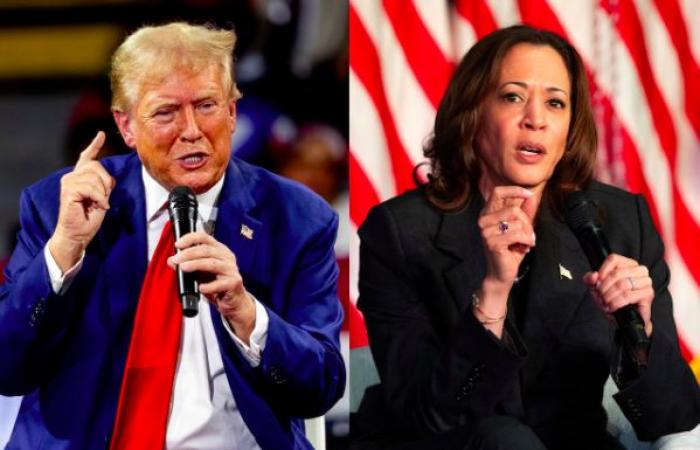November 5, 2024
In mid-September, a few weeks after a national convention which had succeeded in unifying the Democratic Party and after a successful performance during the presidential debate on September 10, 2024, victory seemed promised to Kamala Harris. A few weeks later, at the beginning of October, it found itself once again closely followed by Donald Trump in the opinion polls of pivotal states (Swing States), and this without her having made any major error in her campaign and without him having, for his part, modified anything in his campaign behavior, quite the contrary. On election day, and while millions of voters have already voted in advance, uncertainty remains as to the outcome of this electoral campaign. In key states, all opinion polls are within the margin of error, making this the closest election since 2000 and George W. Bush’s victory over Al Gore, thanks to 537 votes. advances in the state of Florida. What makes this US presidential election so unpredictable?
We formulate the hypothesis that this state of the election can be explained, if not exclusively, at least in part, by the collision of two political phenomena: an extreme political polarization of the country and, with regard to opinion surveys, a potential or anticipated political realignment. One is a phenomenon now well established, documented and at work, the second is a slow and long-term process, uncertain and contested, like a trend of which we do not know if it will be confirmed at the polls on November 5.
One certainty: extreme political polarization
The current electoral dynamic is the product of the extreme political polarization of the country, which does not spare the pivotal states. A phenomenon which, in its contemporary form, finds its origins in the 1990s, and the ideological reorientation initiated by the Republican Party under the influence of the former speaker in the House of Representatives (1995-1999), Newt Gingrich. This political polarization results in the division of the political spectrum into two forces with radically opposed positions on all political subjects and between which there is almost no possibility or desire for compromise. In 2014, a Pew Research Center report highlighted increasing animosity between members of the two political forces, to the point where negative views of the other party had doubled since the 1990s. By 2024, two blocs political and ideological (but not necessarily sociological) clash, one democratic-liberal-progressive, the other republican-conservative-nationalist, who no longer even agree on the reality of the facts.
This polarization is verified in the electoral behavior of citizens identifying with the two main political parties. Trends observed over the last twenty-five years show that approximately 90% of citizens who identify with a party vote for the candidate of that party in the presidential election, regardless of the candidate, his program, his past, his behavior , and this out of partisan loyalty. It is therefore extremely difficult to convince a supporter of the other party to vote for the competing party; consequently, only variations within the bloc of Independents allow candidates to marginally expand their electoral base.
Unable to count on the massive support of defectors from the other camp or independents (who represent nearly 40% of voters), the two main candidates for the presidential election can only hope to win the election on the condition of massively mobilize their traditional support. Which makes electoral participation in key states the central variable of the election.
An uncertainty: electoral realignment or dealignment in progress
From CNN to the Washington Post, from the Pew Research Center to the New York Times, conservative or progressive, in this election year, the question of electoral realignment in the United States is agitating political commentators; some to confirm it, others to put it into perspective or to contest it. In view of the opinion surveys carried out during this electoral cycle, trends seem to be emerging, which fuel a tendential electoral realignment or perhaps, as the historian Timothy Shenk points out, a dealignment, that the result of the elections of November 5 will clarify or refute.
Timothy Shenk, professor of history at George Washington University (Washington DC) defines a realignment as a lasting change in the composition of political coalitions, to which we could add a change in the subjects around which the coalition is structured. political life and the electoral behavior of individuals. On the other hand, he defines a dealignment as a break in traditional partisan identifications, without this giving rise to lasting alternatives.
During this campaign, numerous opinion surveys reported changes in the electoral attitudes of certain social groups traditionally associated with the Democratic Party, opening the way to a discussion around a potential realignment.
Kamala Harris is at the head of a broad but heterogeneous political coalition, made up of moderate Democrats and others more left-wing, unions, racial and ethnic minorities, women’s rights organizations, populations young people and graduates, etc. The Democratic candidate’s initial strategy, aimed at taking no risks, to avoid alienating different segments of her coalition, stalled somewhat in October, when, after the euphoria of the summer, opinion polls revealed the shaky nature of his coalition. So many weak signals which could suggest an electoral realignment (or at least a dealignment).
We thus learned, in turn, that white unionized workers, young African-Americans, a part of the young male population (18-29 years old), graduates, but also members of the Hispanic-American communities, or even Members of the Arab American community, all traditionally identified as Democrats, had shown a certain interest in the candidacy of Donald Trump, or at the very least a disinterest in that of Kamala Harris. Cultural identity versus class identity for some, attraction to a masculinist message for others, economic reasons, religious influence, war in Gaza, disappointment with the Democratic Party, all structural or circumstantial reasons which alienate certain social groups of the Democratic Party and its candidate, and which signal transformations in the electoral behavior of certain groups. While it remains to be seen how this will translate at the polls on November 5 – vote Trump, abstain, or vote Harris – the fact remains that these electoral attitudes will have an impact on the outcome of the elections and on the future strategy of the party Democrat and the political coalition formed around him. Whether this is a long-term trend, a reaction to disappointment with the Biden presidency, or a problem with the candidate, future election cycles will tell.
But the potential realignment is not limited to those Democratic coalition members attracted from other political backgrounds. We also find it at work, but in an even more uncertain manner, within the Republican Party.
To deal with possible abstentions or votes in favor of Donald Trump, Kamala Harris’ campaign has decided not to concentrate only on this electoral base, but also to try to broaden it by turning towards the wing moderate or anti-Trump of the Grand Old Party (GOP), like the Cheney family, father and daughter. By bringing together many Republican elected officials on October 16, in Bucks County, Pennsylvania; by participating in three campaign meetings with Liz Cheney on October 21 in the residential suburbs (suburbs) from Detroit (Michigan), Milwaukee (Wisconsin) and Philadelphia (Pennsylvania); and by giving an interview to the Fox News television channel, Kamala Harris made a bet, risky because without certainty, which aims to convince three specific groups to vote for her: firstly, the share of Republican sympathizers who voted for Nikki Halley – and against Donald Trump – during the Republican primary; then, white women from the residential suburbs exasperated by the Republican candidate; finally, and perhaps most importantly, independent voters, who might look favorably on a candidate attempting to break partisan lines and might interpret this as a sign of moderation. Are we witnessing a contingency strategy linked to the person of Donald Trump? How will the Republican Party evolve once Trump is gone, in a few days or in four years? How, once the emergency of the election has passed, will the Democratic Party digest a strategy of opening to the center and the Republican Party, rather than responding to the expectations and indignation of its traditional base? So many questions which will find some answers in the coming days, but especially in the coming months.
Whether what is currently at work is called realignment or dealignment, it collides with the phenomenon of political polarization at work in American political life for several decades now. Indeed, polarization suggests blocks that are impervious to each other, while the phenomenon of realignment suggests a transformation of partisan loyalties and transpartisan mobility. The apparent contradiction between these two phenomena, and the difficulty in measuring, at this stage, the reality of the electoral realignment at work, if it actually takes place, makes this campaign indecipherable, and this election also indecisive.
Did you enjoy this article?
Support Telos by making a donation
(and benefit from a 66% tax reduction)
Please enter a description
Please enter an amount
Please enter an Invoice ID






